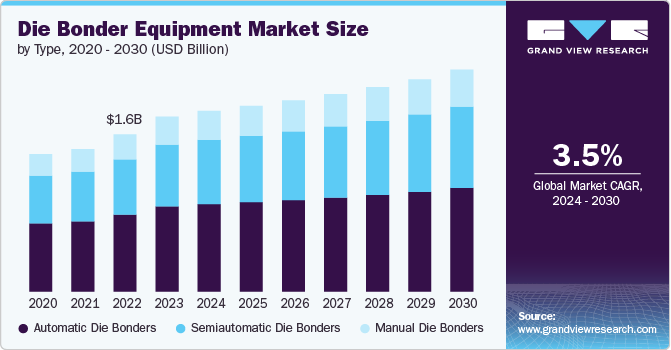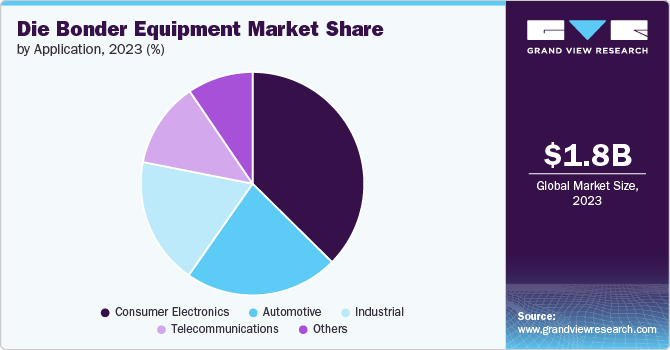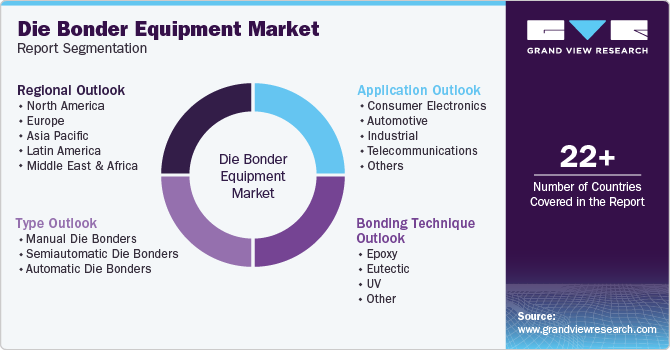- Home
- »
- Advanced Interior Materials
- »
-
Die Bonder Equipment Market Size & Share Report, 2030GVR Report cover
![Die Bonder Equipment Market Size, Share & Trends Report]()
Die Bonder Equipment Market Size, Share & Trends Analysis Report By Product (Manual Die Bonders, Automatic Die Bonders), By Application (Automotive, Industrial), By Bonding Technique, By Region, And Segment Forecasts, 2024 - 2030
- Report ID: GVR-4-68040-421-9
- Number of Report Pages: 152
- Format: PDF, Horizon Databook
- Historical Range: 2018 - 2022
- Forecast Period: 2024 - 2030
- Industry: Advanced Materials
Die Bonder Equipment Market Size & Trends
The global die bonder equipment market size was estimated at USD 1,821.0 million in 2023 and is projected to grow at a CAGR of 3.5% from 2024 to 2030. The market is currently experiencing robust growth, attributed largely to the increasing demand for semiconductor devices across various industries, including automotive, consumer electronics, and IT & telecommunications. This surge in demand is fueled by ongoing technological advancements and the growing need for high-performance and miniaturized electronic components. As devices become more integrated and complex, the precision and efficiency offered by die bonder equipment become crucial, driving manufacturers to invest in the latest technologies to stay competitive.

Advancements in die bonding technologies, such as the development of automated and semi-automated systems, are significantly contributing to the market's growth. These technologies not only improve the throughput and accuracy of the die bonding process but also reduce the likelihood of human error, ensuring higher product reliability. Furthermore, the push for electric vehicles and the expansion of 5G networks globally are creating substantial opportunities for die bonder equipment manufacturers, as these sectors require sophisticated semiconductors produced with high-precision equipment.
Die bonder equipment varies significantly in terms of precision, speed, and bonding techniques to meet the diverse needs of different semiconductor devices and applications. It is a sophisticated piece of machinery designed to handle the delicate process of placing and securing dies, requiring precision alignment and bonding capabilities to ensure high yields and reliability of the final electronic component.
Drivers, Opportunities & Restraints
The exponential growth of the market is fueled by the escalating demand for semiconductor devices across diverse sectors, including automotive, consumer electronics, and healthcare. This surge is significantly attributed to technological advancements, such as the fabrication of intricate microelectronic devices, the ongoing trend of component miniaturization, and the introduction of 5G technology, all of which necessitate refined die bonding techniques. Moreover, the shift towards automation and the incorporation of artificial intelligence in manufacturing processes underscore the need for more sophisticated, efficient, and precise die bonder equipment, bolstering the market's expansion.
With the rapid expansion of the Internet of Things (IoT), wearable technology, and smart devices, there is a significant opportunity for the market to expand its reach. The automotive industry, with its increasing focus on electric vehicles (EVs) and autonomous vehicles, presents another lucrative segment for growth. These sectors require high reliability and quality in semiconductor devices, which can only be achieved with advanced packaging technologies, thereby creating opportunities for innovations and advancements in die bonding equipment. In addition, the push towards renewable energy and power electronics offers new avenues for the application of die bonding technology.
One of the major restraints facing the market is the high initial investment and maintenance costs associated with these high-precision machines. This can be particularly challenging for small and medium-sized enterprises (SMEs). Furthermore, the complexity of semiconductor device manufacturing processes requires skilled technicians and engineers, leading to a challenge in the availability of trained personnel.
Type Insights
“The demand for manual die bonders segment is expected to grow at a CAGR of 4.1% from 2024 to 2030 in terms of revenue.”
The automatic die bonders segment led the market and accounted for 48.7% of the global revenue share in 2023. The automatic die bonders segment’s significant growth is driven by the increasing demand for high precision and efficiency in the semiconductor manufacturing process. These machines are critical for the accurate placement of dies onto substrates, offering advanced capabilities such as high-speed bonding, flexibility in handling different die sizes, and the ability to work with various substrates. This makes them indispensable for applications requiring high throughput and precision, such as advanced consumer electronics, automotive electronics, and LED lighting technologies.
The manual die bonders segment remains a vital part of the market, catering to applications where precision, flexibility, and customization are paramount. These systems are especially favored in research and development environments, prototype manufacturing, and specialized low-volume production, where the intricacies of the bonding process can be manually adjusted and closely monitored. This will further drive the demand for market growth.
Bonding Technique Insights
“The demand for UV segment is expected to grow at a CAGR of 4.5% from 2024 to 2030 in terms of revenue.”
The epoxy segment led the market and accounted for 33.5% of the global revenue share in 2023. Epoxy based die bonding is widely used in the assembly of semiconductor devices, particularly where high reliability under harsh environmental conditions is crucial, such as in automotive and military applications. This adhesive method is favored for its versatility, allowing for bonding a wide range of materials, including those with mismatched coefficients of thermal expansion. The strength of epoxy bonds, coupled with their longevity and the ability to cure at room temperature or with heat, makes epoxy an attractive choice for manufacturers seeking to enhance device performance and reliability.
The UV (ultraviolet) curing segment in the market is gaining traction, particularly for applications requiring rapid processing and high throughput. UV curing technology uses ultraviolet light to quickly cure or solidify photo-reactive polymers, offering a faster, more efficient bonding process compared to traditional thermal curing methods. This technology is highly valued in the electronics manufacturing sector, where speed and precision are critical to productivity and profitability. UV curing is well-suited for complex, high-density electronic assemblies where thermal management is crucial, as it minimizes thermal stress on delicate components. The above factor may positively impact the market growth.
Application Insights
“The demand from the automotive application segment is expected to grow at a significant CAGR of 3.0% from 2024 to 2030 in terms of revenue”
The consumer electronics segment held a 37.4% revenue share of the global market in 2023. The consumer electronics segment is a major driving force in the market, propelled by the escalating demand for smaller, more powerful, and energy-efficient devices such as smartphones, tablets, laptops, and wearables. As these devices evolve, becoming more complex with each iteration, the need for precise, reliable die bonding processes intensify. Die bonder equipment plays a crucial role in the assembly of semiconductor chips within these devices, ensuring the integrity and performance of the final product.

The automotive segment represents a significant and growing avenue in the market, underscored by the increasing electronic content in vehicles and the push toward electric and autonomous driving technologies. As modern vehicles incorporate more sophisticated electronic systems for navigation, safety, infotainment, and vehicle management, the precision and reliability of semiconductor components become paramount. Die bonder equipment is essential in the production of these components, offering the high-precision bonding necessary for ensuring the durability and reliability required in the automotive environment, which often involves exposure to extreme temperatures, vibrations, and moisture.
Regional Insights
“China to witness fastest market growth at 4.6% CAGR”
The North America die bonder equipment market is propelled by the region's robust technological advancement, particularly in the semiconductor and electronics sectors. This growth is bolstered by the presence of leading semiconductor manufacturers and a strong focus on research and development activities, aiming to meet the escalating demand for more sophisticated and efficient electronics. Factors such as the surge in demand for consumer electronics, the rise of electric vehicles requiring advanced semiconductor components, and the growing need for miniaturized electronic devices further fuel the market's expansion. In addition, the push for 5G technology and IoT (Internet of Things) applications in North America plays a crucial role in driving the demand for die bonder equipment.
Asia Pacific Die Bonder Equipment Market Trends
The Asia Pacific die bonder equipment market holds a significant share in the global die bonder equipment market, mainly driven by the booming semiconductor industry in countries such as China, South Korea, Japan, and Taiwan. The substantial demand for consumer electronics, the increasing adoption of advanced technologies such as 5G, IoT (Internet of Things), artificial intelligence (AI), and electric vehicles (EVs), and strong government support for semiconductor self-sufficiency and technological advancements are anticipated to drive the demand for die bonder equipment over the forecast period.
The die bonder equipment market in China is estimated to grow at a significant CAGR of 5.1% over the forecast period. China's market is undergoing substantial growth, fuelled by the country's ambitious efforts to become self-sufficient in semiconductor manufacturing. The Chinese government's substantial financial and policy support for the semiconductor sector, as part of its Made in China 2025 initiative, has led to an increase in the number of semiconductor fabrication plants (fabs) and research and development activities in the country. This expansion is driving the demand for die bonder equipment, which is crucial in the assembly process of semiconductors, as China aims to climb up the value chain in semiconductor production.
Europe Die Bonder Equipment Market Trends
The die bonder equipment market in Europe is experiencing steady growth, driven by the region's strong focus on the automotive, healthcare, and industrial electronics sectors. Europe's commitment to innovation and sustainability, particularly in automotive manufacturing with a surge in electric vehicle production, necessitates advanced semiconductor components, thereby increasing the demand for die bonder equipment. Moreover, Europe's emphasis on advanced medical devices for its aging population and the region's push towards Industry 4.0 is further catalyzing the growth of the market.
Key Die Bonder Equipment Company Insights
Some of the key players operating in the market include Kulicke & Soffa Industries, TRESKY GmbH, and Shibuya Corporation.
-
Kulicke & Soffa Industries, widely recognized by its abbreviation K&S, is a premier global provider of semiconductor assembly and packaging equipment and solutions. The company's product portfolio encompasses a broad range of equipment designed to support multiple steps in the semiconductor manufacturing process, with a particular focus on wire bonding and die bonding technologies.
-
TRESKY GmbH specializes in the development and manufacture of manual to fully automatic die bonding systems. The company's die bonding equipment is highly versatile, catering to a wide array of applications including R&D, prototyping, and volume production across various sectors such as photonics, hybrid circuits, microwave devices, and optoelectronics.
West·Bond, Inc., Palomar Technologies, and Finetech GmbH & Co. KG are some of the emerging market participants in the market.
-
West·Bond, Inc., is a distinguished player in the precision manufacturing industry. It is known for its design, production, and sale of advanced wire bonding, wire pull, and die attach equipment. The company caters to a wide range of markets, including semiconductor packaging, aerospace, medical, and research industries.
-
Finetech GmbH & Co. KG has expertise in manufacturing and providing micro-assembly and bonding solutions for high-precision electronic components. Finetech develops equipment that supports a myriad of applications, from research and development to automated production. With a strong commitment to innovation and quality, Finetech equips industries such as semiconductors, photonics, and medical devices with tools essential for the miniaturization of electronic components.
Key Die Bonder Equipment Companies:
The following are the leading companies in the die bonder equipment market. These companies collectively hold the largest market share and dictate industry trends.
- MicroAssembly Technologies, Ltd.
- West·Bond, Inc.
- Kulicke & Soffa Industries
- TRESKY GmbH
- Shibuya Corporation
- ASM Pacific Technology
- Palomar Technologies
- Hybond Inc.
- MRSI Systems
- Finetech GmbH & Co. KG
- Besi
- ITEC
- SHINKAWA Electric Co., Ltd.
Recent Developments
-
In May 2024, ITEC introduced the ADAT3 XF TwinRevolve Flip-Chip Die Bonder, which is changing the game in the electronics manufacturing industry. This cutting-edge piece of equipment is reported to operate at speeds up to five times faster than competing die bonders on the market.
-
In September 2022, MRSI Systems, a part of the prestigious Mycronic Group, launched the MRSI-HVM1 and MRSI-H1 die bonders. These state-of-the-art machines are designed to push the boundaries of precision in die bonding technology, boasting an unparalleled machine accuracy of 1µm.
Die Bonder Equipment Market Report Scope
Report Attribute
Details
Market size value in 2024
USD 1,880.9 million
Revenue forecast in 2030
USD 2,311.3 million
Growth Rate
CAGR of 3.5% from 2024 to 2030
Base year for estimation
2023
Historical data
2018 - 2022
Forecast period
2024 - 2030
Quantitative units
Revenue in USD million/billion and CAGR from 2024 to 2030
Report coverage
Revenue forecast, company market position analysis, competitive landscape, growth factors, and trends
Segments covered
Type, bonding technique, application, region
Regional scope
North America, Europe, Asia Pacific, Latin America, and Middle East & Africa
Country Scope
U.S., Canada, Mexico, Germany, France, Italy, UK, Spain, China, Japan, India, South Korea, Australia, Brazil, Argentina, South Africa, Saudi Arabia, UAE
Key companies profiled
MicroAssembly Technologies, Ltd., West·Bond, Inc., Kulicke & Soffa Industries, TRESKY GmbH, Shibuya Corporation, ASM Pacific Technology, Palomar Technologies, Hybond Inc., MRSI Systems, Finetech GmbH & Co. KG, Besi, SHINKAWA Electric Co., Ltd. ITEC.
Customization scope
Free report customization (equivalent up to 8 analysts working days) with purchase. Addition or alteration to country, regional & segment scope.
Pricing and purchase options
Avail customized purchase options to meet your exact research needs. Explore purchase options
Global Die Bonder Equipment Market Report Segmentation
This report forecasts revenue growth at global, regional & country levels and provides an analysis of the industry trends in each of the sub-segments from 2018 to 2030. For this study, Grand View Research has segmented the global die bonder equipment market based on type, bonding technique, application, and region:

-
Type Outlook (Revenue, USD Million; 2018 - 2030)
-
Manual Die Bonders
-
Semiautomatic Die Bonders
-
Automatic Die Bonders
-
-
Bonding Technique Outlook (Revenue, USD Million; 2018 - 2030)
-
Epoxy
-
Eutectic
-
UV
-
Other
-
-
Application Outlook (Revenue, USD Million; 2018 - 2030)
-
Consumer Electronics
-
Automotive
-
Industrial
-
Telecommunications
-
Others
-
-
Regional Outlook (Revenue, USD Million; 2018 - 2030)
-
North America
-
U.S.
-
Canada
-
Mexico
-
-
Europe
-
UK
-
Germany
-
France
-
Italy
-
Spain
-
-
Asia Pacific
-
Japan
-
China
-
India
-
Australia
-
South Korea
-
-
Latin America
-
Brazil
-
Argentina
-
-
Middle East & Africa
-
South Africa
-
Saudi Arabia
-
UAE
-
-
Frequently Asked Questions About This Report
b. The global die bonder equipment market size was estimated at USD 1,821.0 million in 2023 and is expected to reach USD 1,880.9 million in 2024.
b. The global die bonder equipment market, in terms of revenue, is expected to grow at a compound annual growth rate of 3.5% from 2024 to 2030 to reach USD 2,311.3 million by 2030.
b. Asia Pacific dominated the die bonder equipment market with a revenue share of 47.5% in 2023. The Asia Pacific region holds a significant share in the global die bonder equipment market, mainly driven by the booming semiconductor industry in countries such as China, South Korea, Japan, and Taiwan.
b. Some of the key players operating in the die bonder equipment market include MicroAssembly Technologies, Ltd., West·Bond, Inc., Kulicke & Soffa Industries, TRESKY GmbH, Shibuya Corporation, ASM Pacific Technology, Palomar Technologies, Hybond Inc., MRSI Systems, Finetech GmbH & Co. KG, Besi , SHINKAWA Electric Co., Ltd. ITEC.
b. The die bonder equipment market is currently experiencing robust growth, attributed largely to the increasing demand for semiconductor devices across various industries including automotive, consumer electronics, and IT & telecommunications. This surge in demand is fueled by the ongoing technological advancements and the growing need for high-performance and miniaturized electronic components.
Share this report with your colleague or friend.
![gvr icn]()
NEED A CUSTOM REPORT?
We can customize every report - free of charge - including purchasing stand-alone sections or country-level reports, as well as offer affordable discounts for start-ups & universities. Contact us now
![Certified Icon]()
We are GDPR and CCPA compliant! Your transaction & personal information is safe and secure. For more details, please read our privacy policy.
We are committed towards customer satisfaction, and quality service.
"The quality of research they have done for us has been excellent."





